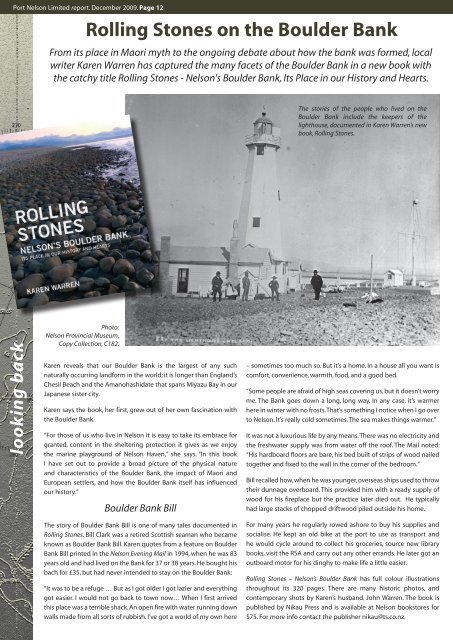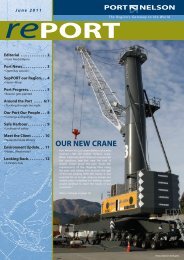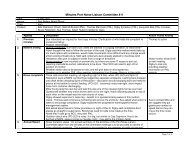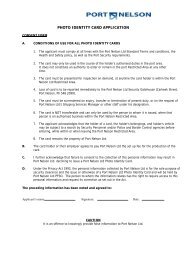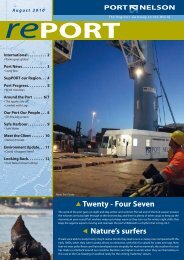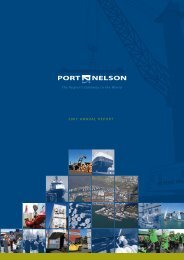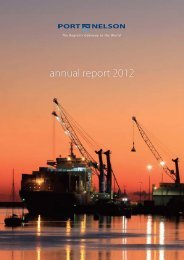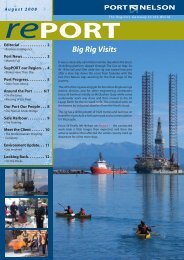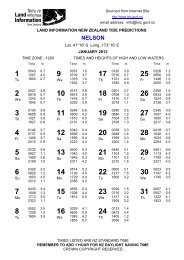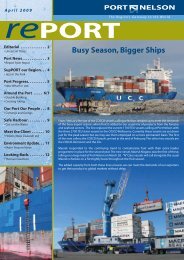December 2009 (pdf) - Port Nelson
December 2009 (pdf) - Port Nelson
December 2009 (pdf) - Port Nelson
Create successful ePaper yourself
Turn your PDF publications into a flip-book with our unique Google optimized e-Paper software.
<strong>Port</strong> <strong>Nelson</strong> Limited report. <strong>December</strong> <strong>2009</strong>. Page 12<br />
looking back<br />
Rolling Stones on the Boulder Bank<br />
From its place in Maori myth to the ongoing debate about how the bank was formed, local<br />
writer Karen Warren has captured the many facets of the Boulder Bank in a new book with<br />
the catchy title Rolling Stones - <strong>Nelson</strong>'s Boulder Bank, Its Place in our History and Hearts.<br />
Photo:<br />
<strong>Nelson</strong> Provincial Museum,<br />
Copy Collection, C182.<br />
Karen reveals that our Boulder Bank is the largest of any such<br />
naturally occurring landform in the world; it is longer than England’s<br />
Chesil Beach and the Amanohashidate that spans Miyazu Bay in our<br />
Japanese sister city.<br />
Karen says the book, her first, grew out of her own fascination with<br />
the Boulder Bank.<br />
“For those of us who live in <strong>Nelson</strong> it is easy to take its embrace for<br />
granted, content in the sheltering protection it gives as we enjoy<br />
the marine playground of <strong>Nelson</strong> Haven,” she says. “In this book<br />
I have set out to provide a broad picture of the physical nature<br />
and characteristics of the Boulder Bank, the impact of Maori and<br />
European settlers, and how the Boulder Bank itself has influenced<br />
our history.”<br />
Boulder Bank Bill<br />
The story of Boulder Bank Bill is one of many tales documented in<br />
Rolling Stones. Bill Clark was a retired Scottish seaman who became<br />
known as Boulder Bank Bill. Karen quotes from a feature on Boulder<br />
Bank Bill printed in the <strong>Nelson</strong> Evening Mail in 1994, when he was 83<br />
years old and had lived on the Bank for 37 or 38 years. He bought his<br />
bach for £35, but had never intended to stay on the Boulder Bank:<br />
“It was to be a refuge … But as I got older I got lazier and everything<br />
got easier. I would not go back to town now… When I first arrived<br />
this place was a terrible shack. An open fire with water running down<br />
walls made from all sorts of rubbish. I’ve got a world of my own here<br />
The stories of the people who lived on the<br />
Boulder Bank include the keepers of the<br />
lighthouse, documented in Karen Warren’s new<br />
book, Rolling Stones.<br />
– sometimes too much so. But it’s a home. In a house all you want is<br />
comfort, convenience, warmth, food, and a good bed.<br />
“Some people are afraid of high seas covering us, but it doesn’t worry<br />
me. The Bank goes down a long, long way. In any case, it’s warmer<br />
here in winter with no frosts. That’s something I notice when I go over<br />
to <strong>Nelson</strong>. It’s really cold sometimes. The sea makes things warmer.”<br />
It was not a luxurious life by any means. There was no electricity and<br />
the freshwater supply was from water off the roof. The Mail noted:<br />
“His hardboard floors are bare, his bed built of strips of wood nailed<br />
together and fixed to the wall in the corner of the bedroom.”<br />
Bill recalled how, when he was younger, overseas ships used to throw<br />
their dunnage overboard. This provided him with a ready supply of<br />
wood for his fireplace but the practice later died out. He typically<br />
had large stacks of chopped driftwood piled outside his home.<br />
For many years he regularly rowed ashore to buy his supplies and<br />
socialise. He kept an old bike at the port to use as transport and<br />
he would cycle around to collect his groceries, source new library<br />
books, visit the RSA and carry out any other errands. He later got an<br />
outboard motor for his dinghy to make life a little easier.<br />
Rolling Stones – <strong>Nelson</strong>’s Boulder Bank has full colour illustrations<br />
throughout its 320 pages. There are many historic photos, and<br />
contemporary shots by Karen’s husband, John Warren. The book is<br />
published by Nikau Press and is available at <strong>Nelson</strong> bookstores for<br />
$75. For more info contact the publisher nikau@ts.co.nz.


